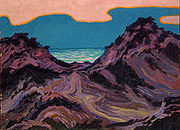
Wenzel Hablik
Encyclopedia

German Expressionism
German Expressionism refers to a number of related creative movements beginning in Germany before the First World War that reached a peak in Berlin, during the 1920s...
.
Hablik was born in Brüx, Bohemia (now the city of Most
Most
Most is the capital city of the Most District, situated between the Czech Central Mountains and the Ore Mountains, approximately northwest of Prague along the Bílina River and southwest of Ústí nad Labem.-Etymology:...
in the Czech Republic
Czech Republic
The Czech Republic is a landlocked country in Central Europe. The country is bordered by Poland to the northeast, Slovakia to the east, Austria to the south, and Germany to the west and northwest....
). In later life he recalled that at the age of six, he found a specimen of crystal, and saw in it "magical castles and mountains" that would later appear in his art.
More pragmatically, he trained as a master cabinetmaker, in Teplitz, Vienna
Vienna
Vienna is the capital and largest city of the Republic of Austria and one of the nine states of Austria. Vienna is Austria's primary city, with a population of about 1.723 million , and is by far the largest city in Austria, as well as its cultural, economic, and political centre...
, and Prague
Prague
Prague is the capital and largest city of the Czech Republic. Situated in the north-west of the country on the Vltava river, the city is home to about 1.3 million people, while its metropolitan area is estimated to have a population of over 2.3 million...
. He settled in Itzehoe
Itzehoe
Itzehoe is a town in the German state of Schleswig-Holstein.As the capital of the district Steinburg, Itzehoe is located on the Stör, a navigable tributary of the Elbe, 51 km northwest of Hamburg and 24 km north of Glückstadt...
in 1907, where he pursued architectural and interior design projects. Hablik produced designs for furniture, textiles, tapestries, jewelry, cutlery, and wallpapers. He married the weaver and fabric designer Lisbeth Lindemann (1879–1960) in 1917; they shared a workshop and studio in Itezhoe.
Hablik became best known, however, for his etchings and paintings and his links with major German Expressionist figures and movements, including the Arbeitsrat für Kunst
Arbeitsrat für Kunst
The Arbeitsrat für Kunst was a union of architects, painters, sculptors and art writers, who were based in Berlin from 1918 to 1921...
and the Glass Chain
Glass Chain
The Glass Chain or Crystal Chain sometimes known as the "Utopian Correspondence" was a chain letter that took place between November 1919 and December 1920. It was a correspondence of architects that formed a basis of expressionist architecture in Germany. It was initiated by Bruno Taut.-Names,...
. In 1909 Hablik published his Creative Forces ("Schaffende Kräfte"), "a portfolio of twenty etchings portraying a voyage through an imaginary universe of crystalline structures" that "represents the most significant accomplishment of his career." Hablik also published other portfolios of his etchings, The Sea ("Das Meer", 1918) and Architectural Cycle — Utopia ("Cyklus Architektur — Utopie," 1925). Some of Hablik's designs, particularly of lamps and small sculptures, relate to and express the "utopian crystalline" forms of his etchings.

A catalogue in the artist's autograph lists some 600 artworks; about 250 oil paintings by Hablik are known at present. He produced portraits, landscapes, nude figures, and pictures showing Symbolist
Symbolism (arts)
Symbolism was a late nineteenth-century art movement of French, Russian and Belgian origin in poetry and other arts. In literature, the style had its beginnings with the publication Les Fleurs du mal by Charles Baudelaire...
influences. A tour of South America in 1925–26 inspired him to create paintings of cactuses and flowers.
Hablik died at Itzehoe in 1934. A Wenzel Hablik Museum was established in the city in 1995. The museum contains much of his art, as well as his collections of crystals and minerals, seashells and snails.
Selected quotes
Selected quotes from Hablik's Glass Chain letters:- "Come and join the struggle against all things negative and corrupting."
- "Your ideas should be as irresponsibly free as a bird....Let us create a fresh atmosphere, a pure aura of spirit, wit, and joy. "
- "Where are you, prophets? — the heralds of the new life, telling of the new suns — moons — and stars!"

